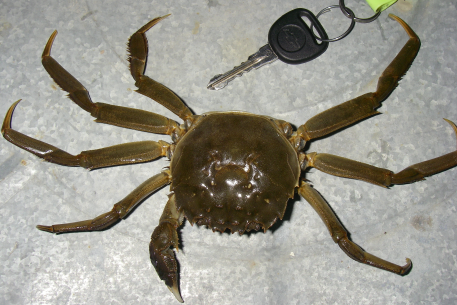Eriocheir sinensis
Chinese Mitten Crab
Class: Crustacea
Order: Decapoda
Family: Grapsidae

Photographer: Smithsonian Environmental Research Center
Source: http://blogs.app.com/enviroguy/
Description
The name mitten crab comes from dense fuzzy patches on the front chelae (pinchers) of adults. The chelae are equally sized and have white markings on the tip of them. The carapace (shell) is a light-brown to olive-green color with a width up to 4 inches. Four pairs of spines are located on the lateral edges of the carapace and the legs are about twice the length of the shell width.
Ecological Threat: An efficient predator and competitor for food, they may have a profound effect on native biological communities. This crab’s flexible, omnivorous feeding habits may give it a competitive edge over other crabs. Also of concern is potential predation on salmon and sturgeon eggs and juveniles. The mitten crab poses a potential human health threat. Mitten crabs often inhabit areas that may contain high levels of contaminants. Accumulation of contaminants could be transferred to predators, including humans. Additionally, Eriocheir sinensis is an intermediate host for the Oriental lung fluke, and mammals, including humans, can become infested by eating raw or poorly cooked mitten crabs. However, neither the lung fluke nor any of the freshwater snails that serve as the primary intermediate host for the fluke in Asia have been found in the Pacific Northwest or California.
In San Francisco Bay, removing the crabs from the nets has been time-consuming and costly to shrimp trawlers (one trawler has reported catching over 200 crabs in a single tow several times), damaging or killing the catch. Another significant problem in California has been the impact on diversion and fish salvage facilities. Mitten crabs have clogged pumps, screens, and intakes and have damaged and killed fish at salvage facilities associated with water diversions. With the declines in salmon and trout populations, any further disruption or damage to fish passage is a major concern. Eriocheir sinensis are gregarious and can form large and isolated populations. With the burrowing nature of the Chinese mitten crab, these populations can cause an extensive system of burrows which causes accelerated bank erosion and instability.
Biology: The Chinese mitten crab life-cycle toggles between freshwater and saltwater conditions. It begins in saltwater conditions where females produce up to one million eggs per brood. The fertilized eggs become zygotes which morph into larvae. The larvae migrate to freshwater streams when they mature in to adults and reside in the freshwater for 1-4 years and then return to the coast to reproduce. Eriocheir sinensis burrow in the bottom for freshwater rivers and estuaries where it is a generalist feeder eating everything from plants to fish and invertebrates. The Chinese mitten crab is able to tolerate a wide range of water temperatures and it able to survive in highly polluted and altered aquatic habitats.
History: In 1992, it was found reproducing in San Francisco Bay. By 1998, Eriocheir sinensis had spread throughout the bay and has since expanded upstream into the Sacramento and San Joaquin Rivers. From 2005-2008, nineteen sites were confirmed along the U.S. Atlantic coast in the Chesapeake Bay, Delaware Bay, Hudson River and To
allast water, and transport by ship when crabs take refuge among the fouling communities on ship hulls.
U.S. Habitat: Coastal rivers, estuaries/bays, wetlands and brackish waters
Distribution
Native Origin: China and Korea
U.S. Present: Established in CA but found in MD, ME, MI, MS, NY, OH, OR, PA
Management
Listed as an injurious wildlife under the Federal Lacey Act; therefore, it is illegal to import eggs or live specimens of any species of mitten crab (genus Eriocheir). If you find a mitten crab washed upon the shore do not throw it back in alive, Instead freeze it and report this to you local, state or federal wildlife entities. In London, museum scientists are experimenting to determine whether the crabs in the River Thames are safe to eat. If they receive a clean bill of health, the crabs could be commercially fished and sold in Asia. This could help with management of crab population in non-native ranges. In Germany, it has been shown that installation of traveling screens and trash racks, in conjunction with collection and disposal efforts, has the potential to drastically reduce a large portion of the mitten crab population during migration events. However, for this strategy to be most effective it needs to be done at a place where the river is entirely contained by a regulatory structure (e.g., dam, fish facility). Unfortunately, most of the established populations are not confined areas; making mechanical or chemical management is very difficult. Do not intentionally spread these crabs. Clean all bait wells, fishing nets and other gear before moving to new areas.
References
Nonindigenous Aquatic Species Database. 2011. Eriocheir sinensis (Chinese mitten crab). USGS, Gainesville, FL.
Woodward, Susan L., and Joyce Ann. Quinn. 2011. Chinese Mitten Crab. Encyclopedia of Invasive Species: From Africanized Honey Bees to Zebra Mussels. Santa Barbara, CA: Greenwood. 86-89. Print.
Internet References
http://www.invasivespeciesinfo.gov/aquatics/mittencrab.shtml#cit
http://www.nhm.ac.uk/nature-online/life/other-invertebrates/chinese-mitten-crabs/index.html
http://www.anstaskforce.gov/spoc/mitten_crab.php
 Texas Invasive Species Institute
Texas Invasive Species Institute